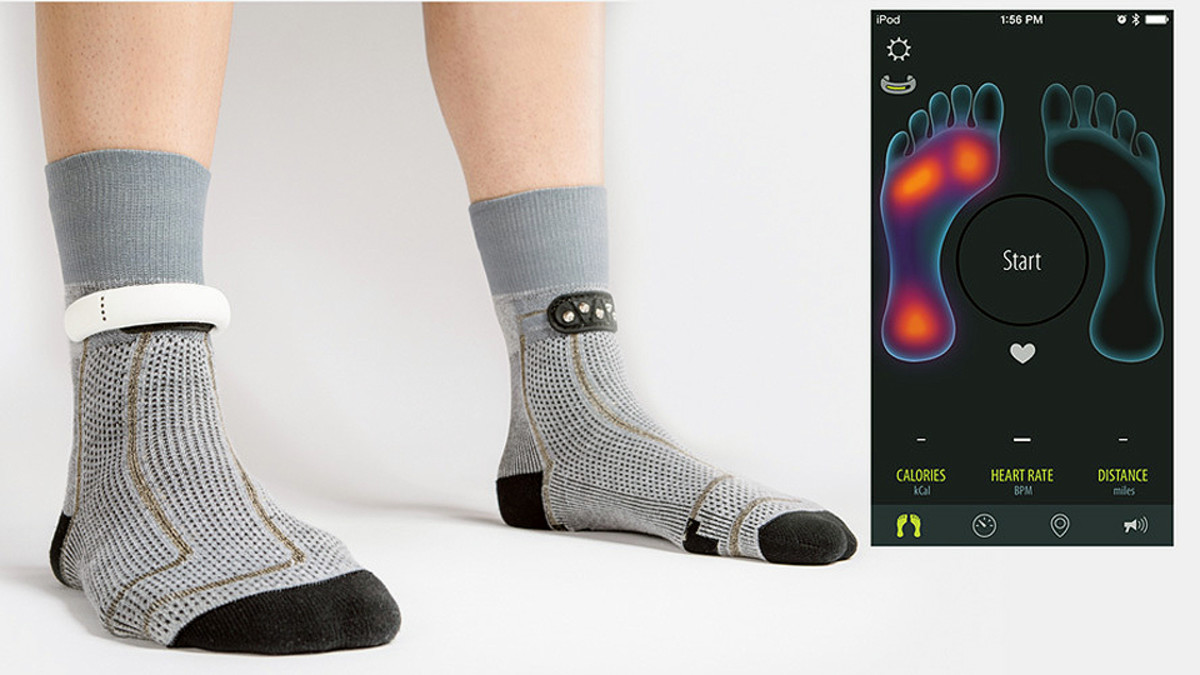
Sensoria's smart socks measure your running patterns, improving gait
Three years ago in a Seattle coffee shop, Mario Esposito’s wife Victoria tripped and spilled the cappuccino she had just bought him over his feet. Instead of leaping up in pain as the hot liquid seeped into his socks, Esposito took a different sort of leap.
A Microsoft engineer—he worked on the first Xbox—and serial inventor, Esposito had been searching for inspiration. Now he had it: socks. Using a chemical process he’s keeping secret, Esposito realized he could convert any fabric into a pressure sensor. “The idea essentially is that every time pressure is applied to this particular fabric,” he says, "the value of resistance changes.”
The sensors themselves have no metallic parts—though metal threads need to be woven into the fabric to transmit signals to a recording device—and so could in theory be incorporated into any piece of clothing without affecting comfort. However, Esposito wanted to go straight for our soles. People recovering from strokes change their gait, and this can be used to evaluate their rehabilitation. “Which means that our feet actually tell us more than you think,” Esposito says.
As well as targeting the sports market, Sensoria is aiming for those sorts of applications in healthcare. Monitoring the pressure through the feet could help detect and prevent falls in the elderly, and looking for areas of high pressure could help prevent diabetic foot ulcers that ultimately can lead to amputation.
[daily_cut]Esposito founded Sensoria together with two other Italian engineers from Microsoft, Davide Vigano and Maurizio Macagno—his company’s Italian influence is so strong that different components are often referred to by the names of pasta. Ultrarunner, adventure racer and biomedical engineer Roger Michel, who runs a trail-running event series in the Pacific Northwest, also provided feedback on what an athlete would want from Sensoria.
Each smart sock has three pressure sensors on the sole, two on the balls of the feet, and one on the heel. Signals from these sensors are conducted back along silver fibers to magnetic studs at the top of the sock, and by connecting an anklet device to these studs the data can be recorded and transmitted via Bluetooth to mobile devices. The reason each sock has three pressure sensors is that's the number of points needed to define a geometric plane. So with just three sensors Sensoria can estimate the distribution of pressure around the plane of the sole.
Sensoria’s smart socks currently retail for $49 for two pairs, and each anklet costs $159. It is generally not necessary to wear an anklet on both feet at the same time, as data from each side can be collected separately, so users don’t have to buy a pair. Additionally customers can purchase a bra or t-shirt ($79 each) that can incorporate a heart rate monitor ($79).
NFL using Zebra RFID chips to track player movements, gather data
Using a mobile app, users can track data such as their pace, the number of steps they have taken and the distance they have travelled. But there is also a virtual coach that can be set up to give real-time advice on their running gait. “It is well known that heel-striking is bad for your knees,” Esposito explains, so the virtual coach could correct the user each time they do that. “You will hear a voice that says ‘you are heel-striking, lean forward.’”
The socks could also help runners find the right shoes. Dedicated running shops often have pressure sensor pads that customers can run across barefoot to measure how their foot lands, and thus predict what type of shoe would suit them best. Those who overpronate, excessively rolling their foot inwards and pushing off almost entirely with the their big toe, or underpronate, rolling outwards, are advised to wear shoes that push the foot back towards neutral. However, apart from personal feel and reduced injury, there generally isn’t a way to test whether or not each shoe actually fixes the problem.
But Esposito explains that this is possible with Sensoria’s socks. A runner wearing the smart socks could go and test out a range of shoes, then look back at the data to determine which produced the most neutral pronation.




